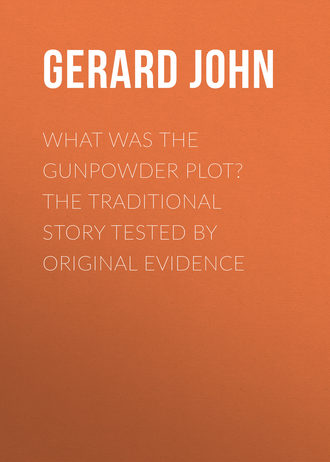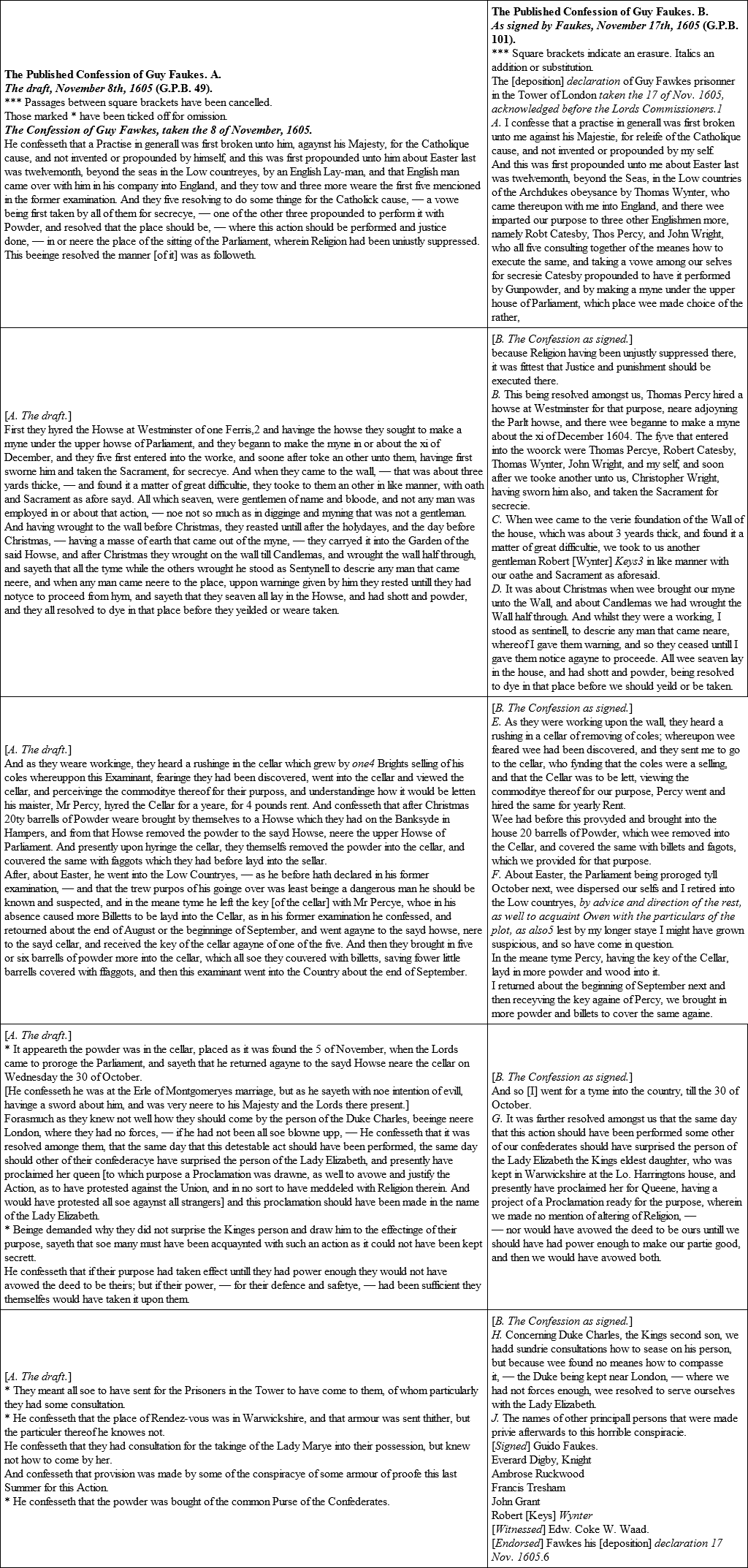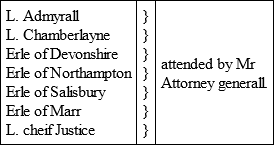 полная версия
полная версияWhat was the Gunpowder Plot? The Traditional Story Tested by Original Evidence
Addressed, "To the Kinge his most excellent Maiestye."
From the absence of any allusion to the Powder Plot and its "discovery," it appears certain that this letter must have been written previously to it.
On August 1st, 1609, Sir Wm. Waad wrote to Salisbury that the disorders of Lord Monteagle's house were an offence to the country. At this period he appears to have been suspected of concealing Catholic students from St. Omers. [Calendar of State Papers.]
APPENDIX I. (p. 140)
Epitaph in St. Anne's, Aldersgate. [Maitland, London (1756), p. 1065.]"Peter Heiwood, younger son of Peter Heiwood, one of the Counsellors of Jamaica, … Great Grandson to Peter Heiwood of Heywood in the County Palestine of Lancaster; who apprehended Guy Faux with his dark Lanthorn; and for his zealous prosecution of Papists, as Justice of Peace, was stabbed in Westminster-Hall by John James, a Dominican Friar, An. Dom. 1640. Obiit Novem. 2. 1701.
Reader, if not a Papist bredUpon such Ashes gently tread."It is to be presumed that the person who died in 1701 is not the same who was stabbed in 1640, or who discovered Guy Faukes in 1605.
The Dominican records contain no trace of any member of the Order named John James, nor does so remarkable an event as the stabbing of a Justice of Peace in Westminster Hall appear to be chronicled elsewhere.
Peter Heywood, J.P. for Westminster, was active as a magistrate as late as December 15th, 1641. [Calendar of State Papers.]
APPENDIX K. (p. 173)
The Use of TortureThere can be no doubt that torture was freely employed to extract evidence from the conspirators and others who fell into the hands of the government.
The Earl of Salisbury, in his letter to Favat, of December 4th, 1605, clearly intimates that this was the case, when he complains "most of the prisoners have wilfully forsworn that the priests knew anything in particular, and obstinately refuse to be accusers of them, yea, what torture soever they be put to."
About the middle of November, Lord Dunfermline wrote to Salisbury [Dom. James I. xvi. 81] recommending that the prisoners should be confined apart and in darkness, that they should be examined by torchlight, and that the tortures should be slow and at intervals, as being thus most effectual.
There is every reason to believe that the Jesuit lay-brother, Nicholas Owen, alias Littlejohn, actually died upon the rack. [Vide Father Gerard's Narrative of the Gunpowder Plot, p. 189.]
Finally we have the king's instructions as to Faukes [Gunpowder Plot Book, No. 17]. "The gentler tortours are to be first usid unto him, et sic per gradus ad ima tenditur,457 and so God speede your goode worke."458 Guy's signature of November 9th is sufficient evidence that it was none of the "gentler tortours" which he had endured.
In the violently Protestant account of the execution of the traitors,459 we read: "Last of all came the great Devil of all Faukes, who should have put fire to the powder. His body being weak with torture and sickness, he was scarce able to go up the ladder, but with much ado, by the help of the hangman, went high enough to brake his neck with the fall."
APPENDIX L. (p. 227)
Myths and Legends of the Powder PlotAround the Gunpowder Plot has gathered a mass of fabulous embellishment too curious to be passed over in silence. This has chiefly attached itself to Guy Faukes, who, on account of the desperate part allotted to him has impressed the public mind far more than any of his associates, and has come to be erroneously regarded as the moving spirit of the enterprise.
One of the best authenticated facts regarding him is that when apprehended he was booted and spurred for a journey, though it is usually said that he was to have travelled by water.
There is, however, a strange story, told with much circumstantiality, which gives an elaborate but incomprehensible account of a tragic underplot in connection with him. This is related at considerable length in a Latin hexameter poem, Venatio Catholica, published in 1609, in the History of the Popish Sham Plots, and elsewhere. According to this tangled tale the other conspirators wished both to get rid of Faukes, when he had served their purpose, and to throw the suspicion of their deed upon their enemies, the Puritans. To this end they devised a notable scheme. A certain Puritan, named Pickering, a courtier, but a godly man, foremost amongst his party, had a fine horse ("Bucephalum egregium"). This, Robert Keyes, his brother-in-law, purchased or hired, and placed at the service of Faukes for his escape. The steed was to await him at a certain spot, but in a wood hard by assassins were to lurk, who, when Guy appeared, should murder him, and having secured the money with which he was furnished, should leave his mangled corpse beside the Bucephalus, known as Mr. Pickering's. Thus Faukes would be able to tell no tales, and – though it does not appear why – suspicion would be sure to fall on the Puritan, and he would be proclaimed as the author of the recent catastrophe.
"Hoc astu se posse rati convertere in hostesFlagitii infamiam, causamque capessere vulgoQua Puritanos invisos reddere possent,Ut tantæ authores, tam immanis proditionis.Cognito equo, et facta (pro more) indagine cædis,Aulicus hic sceleris tanquam fabricator atrocisProclamandus erat, Falso (ne vera referreEt socios sceleris funesti prodere possit)Sublato."Many curious circumstances have likewise been imported into the history, and many places connected with it which appear to have no claim whatever to such a distinction.
Thus we hear (England's Warning Peece) that the Jesuit Cresswell came over from Spain for the occasion "to bear his part with the rest of his society in a victorial song of thanksgiving." Also that on November 5th, a large body of confederates assembled at Hampstead to see the House of Parliament go up in the air.
In the Gentleman's Magazine, February, 1783, is a remarkable description of a summer house, in a garden at Newton Hall, near Kettering, Northamptonshire, in which the plotters used to meet and conspire, the place then belonging to the Treshams; "and for greater security, they placed a conspirator at each window, Guy Faukes, the arch villain, standing in the doorway, to prevent anybody overhearing them."
According to a wide-spread belief Guy Faukes was a Spaniard.460 He has also been called a Londoner, and his name being altered to Vaux, has been said to have a family connection with Vauxhall. He was in fact a Yorkshireman of good family, though belonging to a younger branch of no great estate. His father, Edward Faukes, was a notary at York, where he held the office of registrar and advocate of the cathedral church. Guy himself was an educated man, more than commonly well read. He is always described in the process as "Guido Faukes, Gentleman."
Another most extraordinary example of an obvious myth, which was nevertheless treated as sober history, is furnished by the absurd statement that the astute and wily Jesuits not only contrived the Plot, but published its details to the world long before its attempted execution, in order to vindicate to themselves the credit of so glorious a design. Thus Bishop Kennet, in a fifth of November sermon, preached at St. Paul's before the Lord Mayor, in 1715, tells us:461
"It was a general surmise at least among the whole Order of Jesuits in foreign parts: or else one of them could hardly have stated the case so exactly some four or five years before it broke out. Father Del-Rio, in a treatise printed An. 1600, put the case, as if he had already looked into the Mine and Cellars, and had surveyed the barrels of powder in them, and had heard the whole confessions of Faux and Catesby."
This "general surmise" does not appear to have been confined to the Jesuits themselves. Another ingenious writer, nearly a century earlier,462 tells a wonderful story concerning the sermon of a Dominican, preached in the same year, 1600, wherein it was related how there was a special hell, beneath the other, for Jesuits, so thick and fast did they arrive as to need extra accommodation. The preacher avowed that he had, in his vision of the place, given warning to the demon in charge of it, "to search them with speed, for fear that they had conveyed hither some gunpowder with them, for they are very skilfull in Mine-workes, and in blowing up of whole States and Parliament-houses, and if they can blow you all up, then the Spanyards will come and take your kingdom from you."
Another notable specimen of the way in which reason and probability were cast to the winds is afforded by two letters written from Naples in 1610, one to King James and the other to Salisbury, by Sir Edwin Rich,463 who announced that Father Greenway – who of all the Jesuits was said to be most clearly convicted as a traitor – intended to send to the king a present of an embroidered satin doublet and hose, which, being craftily poisoned, would be death to him if he put them on.
APPENDIX M
Sir William Waad's Memorial InscriptionsIn a room of the Queen's House in the Tower, in which the conspirators are supposed to have been examined by the Lords of the Council, Sir William Waad has left a series of inscriptions as memorials of the events in which he played so large a part. Of these the most noteworthy are the following:
IJacobus Magnus, Magnæ Britanniærex, pietate, justitia, prudentia, doctrina, fortitudine,clementia, ceterisq. virtutibus regiis clariss'; Christianæfidei, salutis publicæ, pacis universalis propugnator, fautorauctor acerrimus, augustiss', auspicatiss'.Anna Regina Frederici 2. Danorum Regis invictiss' filia serenissa,Henricus princeps, naturæ ornamentis, doctrinæ præsidiis, gratiæMuneribus, instructiss', nobis et natus et a deo datus,Carolus dux Eboracensis divina ad omnem virtutem indole,464Elizabetha utriusq. soror Germana, utroque parente dignissimaHos velut pupillam oculi tenellamprovidus muni, procul impiorumimpetu alarum tuarum intrepidosconde sub umbra.[This is evidently intended for a Sapphic stanza, but the last two words of v. 3 have been transposed, destroying the metre.]
IIRobertus Cecil, Comes Sarisburiensis, summus et regisSecretarius, et Angliæ thesaurarius, clariss' patriset de repub. meritissimi filius, in paterna munerasuccessor longe dignissimus;Henricus, comes Northamptoniæ, quinq. portuum præfectus etprivati sigilli custos, disertorum litteratissimus, litteratorumdisertissimus;Carolus comes Nottingamiæ, magnus Angliæ admirallusvictoriosus;Thomas Suffolciæ comes, regis camerarius splendidissimus,tres viri nobilissimi ex antiqua Howardorum familia, ducumq.Norfolciæ prosapia;Edwardus Somersetus, comes Wigorniæ, equis regiis præfectusornatissimus;Carolus Blunt, comes Devoniæ, Hyberniæ prorex et pacificator,Joannes Areskinus,465 illustris Marriæ comes, præcipuarum in Scotiaarcium præfectus;Georgius Humius, Dunbari comes, Scotiæ thesaurariusprudentiss'omnes illustriss' ordinis garteri milites;Joannes Popham, miles, justiciarius Angliæ capitalis,et justitiæ consultissimus:IIIConjuratorum Nomina, ad perpetuam ipsorum infamiam et tantæ diritatis detestationem sempiternam.

Besides the above there is a prolix description of the Plot, devised against the best of sovereigns, "a Jesuitis Romanensibus, perfidiæ Catholicæ et impietatis viperinæ autoribus et assertoribus, aliisq. ejusdem amentiæ scelerisq. patratoribus et sociis susceptæ, et in ipso pestis derepente inferendæ articulo (salutis anno 1605, mensis Novembris die quinto), tam præter spem quam supra fidem mirifice et divinitus detectæ."
There is, moreover, a sentence in Hebrew, with Waad's cipher beneath, and a number of what seem to be meant for verses. The following lines are evidently the Lieutenant's description of his own office:
"Custodis Custos sum, Carcer Carceris, arcisArx, atque Argu' Argus; sum speculæ specula;Sum vinclum in vinclis; compes cum compede, clavuFirmo hærens, teneo tentus, habens habeor.Dum regi regnoq. salus stet firma quieta,Splendida sim Compes Compedis usque licet."
This is considerably more metrical and intelligible than some of the rest.
In 1613 Waad was dismissed from his post, one of the charges against him being that he had embezzled the jewels of Arabella Stuart.466
In Theobald's Memoirs of Sir Walter Raleigh (p. 16), Waad is described as "the Lieutenant of the Tower, and Cecil's great Creature."
APPENDIX N


[Endorsed] Examination of Guy Fauks, Novr 8th, 1605.
1. Alterations and additions (in italics) made by Sir Edward Coke.
2. This name has seemingly been tampered with.
3. Changed by Cecil; but on November 14th, writing to Edmondes, he included Keyes amongst those that "wrought not in the myne," and R. Winter amongst those who did.
4. Interlined.
5. The words italicised are added in the published version.
6. Words in italics added by Coke.
1
1894.
2
Some of these have been partially set forth in a series of six articles appearing in The Month, December 1894 – May, 1895.
3
So he himself always wrote it.
4
Also described as "Great Horses," or "Horses for the great Saddle."
5
"The great object of the Government now was to obtain evidence against the priests." – Gardiner, History of England, i. 267. Ed. 1883.
6
See his despatch in reply. Irish State Papers, vol. 217, 95. Cornwallis received Cecil's letter on November 22nd.
7
See Harington's account of the king's message, Nugæ Antiquæ, i. 374.
8
To Favat. (Copy) Brit. Mus. MSS. Add. 6178, fol. 625.
9
Statutes: Anno 3o Jacobi, c. 1.
10
This work was taken in hand by the Commons, when, in spite of the alarming circumstances of the time, they met on November 5th, and was carried on at every subsequent sitting. The Lords also met on the 5th, but transacted no business. Journals of Parliament.
11
Tresham had died in the Tower, December 22nd. Although he had not been tried, his remains were treated as those of a traitor, his head being cut off and fixed above the gates of Northampton (Dom. James I. xvii. 62.)
12
"That which remaineth is but this, to assure you that ere many daies you shall hear that Father Garnet … is layd open for a principall conspirator even in the particular Treason of the Powder." —To Sir Henry Bruncard, P.R.O. Ireland, vol. 218, March 3rd, 1605-6. Also (Calendar) Dom. James I. xix. 10.
13
In Lent, 1603-4. Easter fell that year on April 8th.
14
"About the middle of Easter Term." —Thomas Winter's declaration, of November 23rd, 1605.
15
"Keyes, about a month before Michaelmas." —Ibid. About Christopher Wright there is much confusion, Faukes (November 17th, 1605) implying that he was introduced before Christmas, and Thomas Winter (November 23rd, 1605) that it was about a fortnight after the following Candlemas, i. e., about the middle of February.
16
The form of this oath is thus given in the official account: "You shall swear by the blessed Trinity, and by the Sacrament you now propose to receive, never to disclose directly or indirectly, by word or circumstance, the matter that shall be proposed to you to keep secret, nor desist from the execution thereof until the rest shall give you leave." It is a singular circumstance that the form of this oath, which was repeated in official publications, with an emphasis itself inexplicable, occurs in only one of the conspirators' confessions, viz., the oft-quoted declaration of T. Winter, November 23rd, 1605. This – as we shall see, a most suspicious document – was one of the two selected for publication, on which the traditional history of the plot depends. Curiously enough, however, the oath, with sundry other matters, was omitted from the published version of the confession.
[Published in the "King's Book: " copy, or draft, for publication, in the Record Office: original at Hatfield. Copy of original Brit. Mus. Add. MSS., 6178, 75.]
17
T. Winter says: "Having upon a primer given each other the oath of secrecy, in a chamber where no other body was, we went after into the next room and heard mass, and received the blessed Sacrament upon the same." —Declaration, November 23rd, 1605.
18
Digby was enlisted "about Michaelmas, 1605;" Rokewood about a month before the 5th of November. Tresham gives October 14th as the date of his own initiation. Examination, November 13th, 1605.
19
This is clear from a comparison of Cecil's private letter to Cornwallis and others (Winwood, Memorials, ii. 170), with the official account published in the Discourse of the manner of the Discovery of the Gunpowder Plot.
20
Criminal Trials, ii. 3.
21
History of England, i. 269 (1883).
22
"We had all been blowne up at a clapp, if God out of His Mercie and just Reuenge against so great an Abomination, had not destined it to be discovered, though very miraculously, even some twelve Houres before the matter should have been put in execution." —Cecil to Cornwallis, November 9th, 1605. Winwood, Memorials, ii. 170.
23
M. l'Abbé Destombes, La persécution en Angleterre sous le règne d'Elizabeth, p. 176.
24
Catholique Apology, third edition, p. 403.
25
Goodman's Court of King James, i. 121.
26
Mr. Sidney Lee, Dictionary of National Biography, sub nom.
27
Goodman's Court of King James, i. 121. Ed. J.S. Brewer.
28
Court of King James, p. 64.
29
Of this affair, – the "Bye" and the "Main," – Goodman says, "[This] I did ever think to be an old relic of the treasons in Q. Elizabeth's time, and that George Brooks was the contriver thereof, who being brother-in-law to the Secretary, and having great wit, small means, and a vast expense, did only try men's allegiance, and had an intent to betray one another, but were all taken napping and so involved in one net. This in effect appears by Brooks' confession; and certainly K. James … had no opinion of that treason, and therefore was pleased to pardon all save only Brooks and the priests." —Court of King James, i. 160.
30
A plain and rational account of the Catholick Faith, etc. Rouen, 1721, p. 200.
31
Dodd, Church History of England, Brussels, 1739, i. 334.
32
Constitutional History, i. 406, note, Seventh Edition. In the same note the historian, discussing the case of Father Garnet, speaks of "the damning circumstance that he was taken at Hendlip in concealment along with the other conspirators." He who wrote thus can have had but a slight acquaintance with the details of the history. None of the conspirators, except Robert Winter, who was captured at Hagley Hall, were taken in concealment, and none at Hendlip, where there is no reason to suppose they ever were. Father Garnet was discovered there, nearly three months later, in company with another Jesuit, Father Oldcorne, on the very day when the conspirators were executed in London, and it was never alleged that he had ever, upon any occasion, been seen in company with "the other conspirators."
33
History, i. 255, note.
34
When James came to the throne Cecil was but a knight. He was created Baron Cecil of Essendon, May 13th, 1603; Viscount Cranborne, August 20th, 1604; Earl of Salisbury, May 4th, 1605.
35
Robert, as the second son, did not succeed to his father's title, which devolved upon Thomas, the eldest, who was created Earl of Exeter on the same day on which Robert became Earl of Salisbury.
36
Fragmenta Regalia, 37. Ed. 1642.
37
He was but little above five feet in height, and, in the phrase of the time, a "Crouchback." King James, who was not a man of much delicacy in such matters, was fond of giving him nicknames in consequence. Cecil wrote to Sir Thomas Lake, October 24th, 1605: "I see nothing yt I can doe, can procure me so much favor, as to be sure one whole day what title I shall have another. For from Essenden to Cranborne, from Cranborne to Salisbury, from Salisbury to Beagle, from Beagle to Thom Derry, from Thom Derry to Parret which I hate most, I have been so walked, as I think by yt I come to Theobalds, I shall be called Tare or Sophie." (R.O. Dom. James I. xv. 105.)
38
History, i. 92.
39
In the same document James I. is spoken of as "the most judycious, learned, and rareste kinge, that ever this worlde produced." (R.O. Dom. James I. xxviii. 29.)
40
Digby to the King, S.P., Spain, Aug. 8. Gardiner, History, ii. 216.
41
At the trial of Essex, Cecil exclaimed, "I pray God to consume me where I stand, if I hate not the Spaniard as much as any man living." (Bruce, Introduction to Secret Correspondence of Sir R. Cecil, xxxiii.)
Of the Spanish pension Mr. Gardiner, after endeavouring to show that originally Cecil's acceptance of it may have been comparatively innocent, thus continues (History of England, i. 216): "But it is plain that, even if this is the explanation of his original intentions, such a comparatively innocent connection with Spain soon extended itself to something worse, and that he consented to furnish the ambassadors, from time to time, with information on the policy and intentions of the English Government… Of the persistence with which he exacted payment there can be no doubt whatever. Five years later, when the opposition between the two governments became more decided, he asked for an increase of his payments, and demanded that they should be made in large sums as each piece of information was given."
At the same time it appears highly probable that he was similarly in the pay of France. Ibid.
42
Queen Elizabeth regarded as treasonable any discussion of the question of the succession.
43
Gardiner, i. 215.
44
Chamberlain to Carleton, July 9th, 1612, R.O.
45
"Tout ce que vous a dit le Comte de Salisbury touchant le mariage d'Espagne est rempli de deguisements et artifices à son accoutumée… Toutefois, je ne veux pas jurer qu'ils négocient plus sincerement et de meilleur foi avec lesdites Espagnols qu'avec nous. Ils corromproient par trop leur naturel, s'ils le faisoient, pour des gens qui ne leur scauroient guère de gré." – Le Fèvre de la Boderie, Ambassade, i. 170.


